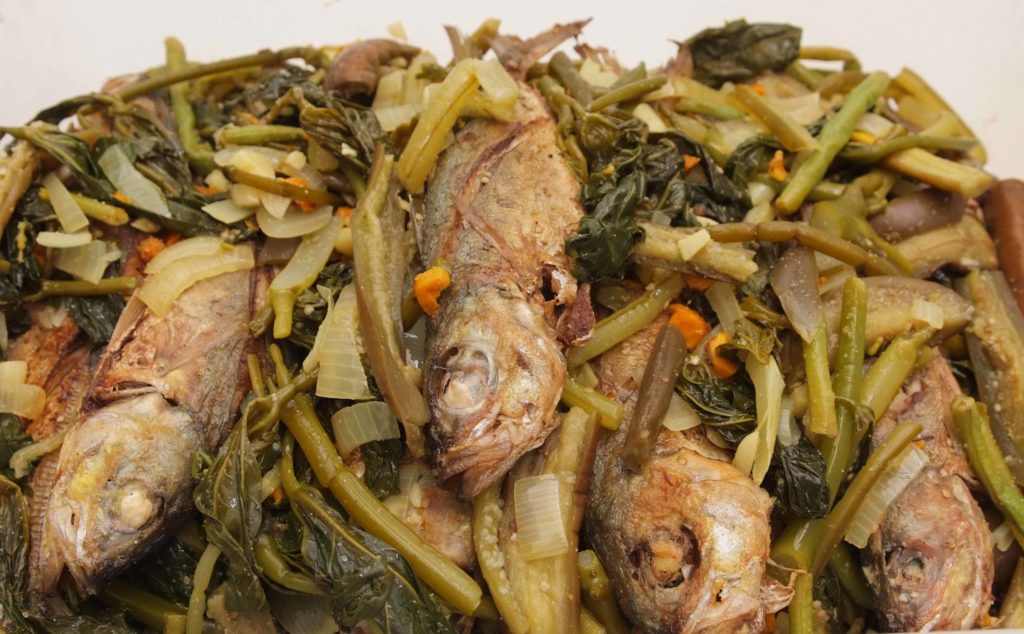Eskabeche: Fish with Vegetables in Vinegar

Description
A dish of poached or fried fish with vegetables in a vinegar sauce.
History
Origin
The origin of the word “escabeche” is Persian. The Arabs brought the word “escabeche” to Spain in the 8th Century. The word is derived from “Al-sikbaj,” a popular meat dish that was cooked in a sweet and sour sauce, usually vinegar and honey or date molasses.
It can be said that Spain brought escabeche (eskabeche in CHamoru, the native language of the Marianas) to the world as it is found in the cuisine of most former Spanish territories from Europe to the Americas, the Philippines, and Guam.
Evolution
The classic Spanish dish is prepared by searing meat or fish and then marinading it in a vinegary sauce loaded with onions, herbs, and spices. It is served cold and can last up to a week if covered with the vinegary sauce.
This dish was introduced to Guam during the Spanish period which began in the 17th century and lasted through the end of the 19th century. While the island was abundant with fish, vinegar was not present in the CHamoru diet prior to the Spanish. Because vinegar is a main ingredient of this dish, eskabeche was probably introduced to Guam after the process of cutting tuba (fermented coconut sap) was introduced from the Philippines.
The dish was adapted to Guam’s staple foods. Two distinct recipes can be found for this dish in the written record. One is for eskabeche “CHamoru style” the other “Filipino style.”
The difference between CHamoru-style and Filipino-style eskabeche is the use of different vegetables and the addition of a thickening agent such as flour or cornstarch used in the Filipino version.
Yellow ginger, or mango’ in CHamoru, is used in older versions of the CHamoru-style eskabeche. Today tumeric can be used.
Preparation
Both men and women can prepare this recipe, but women usually make the dish. It can be made anytime, but usually for the weekend or a special occasion such as a fiesta. This dish is also served during the Lenten season and other days when religious observances call for abstinence from meat.
Placement on table
Eskabeche is placed alongside the fish on the fiesta table. The fish section is the third section coming after the starch section (åggon) and the meat section (totche). The vegetables and salad section follows the kelaguen and fish section, and kadu (soup), if included. The desserts are usually located on a separate table.
Recipe
Eskabeche: Fish with Vegetables in Vinegar
- Fish
- Cooking oil
- Beans (long beans, green beans, etc.)
- Kang kong
- Eggplant
- Cabbage
- Carrots
- Onions
- Green pepper
- Turmeric, fresh if possible
- Vinegar
- Salt
Clean and cook all vegetables except green pepper and onions in boiling water until tender. Reserve at least 2 cups of the cooking water.
Fry fish until barely cooked. Drain most of the oil from pan used to fry fish. Sauté green pepper and onions in the same pan. Add grated or sliced fresh turmeric. (Powdered turmeric may be used if necessary.) Pour in about 2 cups of the vegetable water and about a cup of vinegar. Add salt to taste and bring to a boil.
Arrange cooked fish and vegetables in a large casserole dish or other serving dish. Spoon or pour solution over all. Refrigerated, this will keep for several days.
* Recipe provided by Emilie Johnston, Guam Women’s Club Cookbook